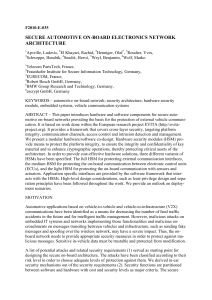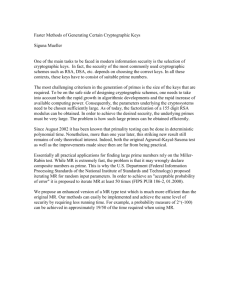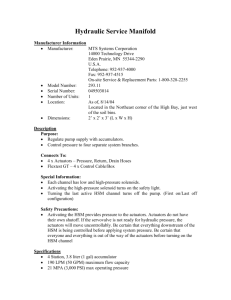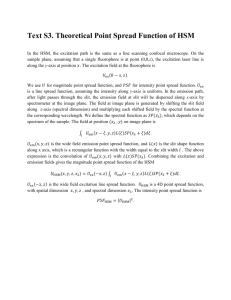paper - Sites personnels de TELECOM ParisTech
advertisement
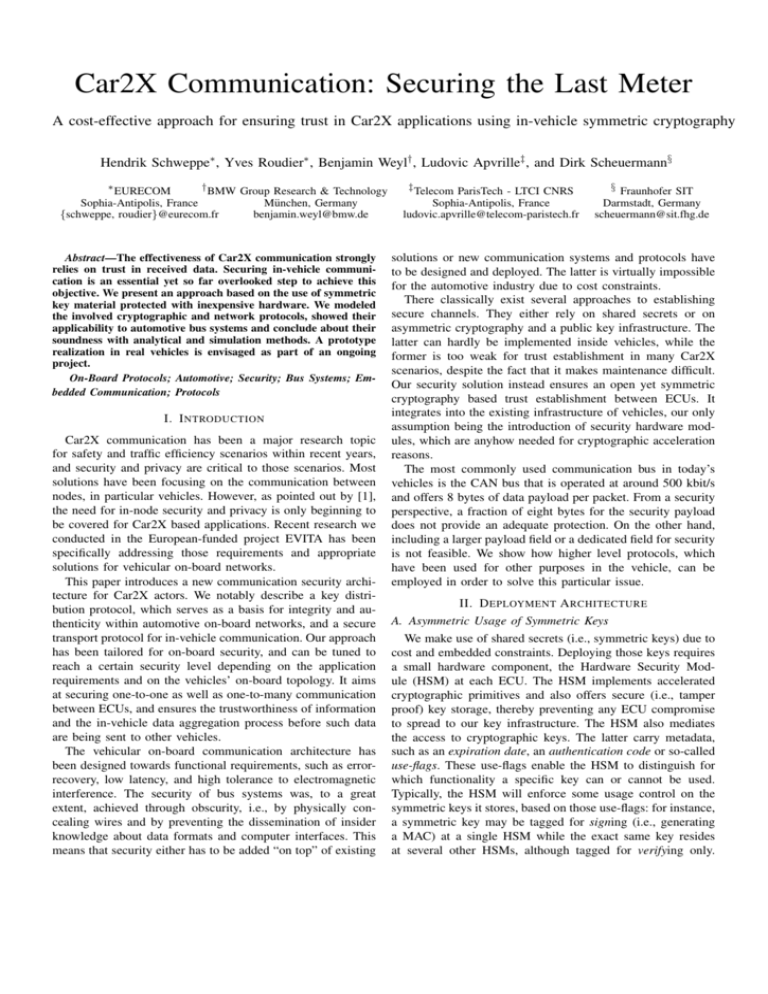
Car2X Communication: Securing the Last Meter
A cost-effective approach for ensuring trust in Car2X applications using in-vehicle symmetric cryptography
Hendrik Schweppe∗ , Yves Roudier∗ , Benjamin Weyl† , Ludovic Apvrille‡ , and Dirk Scheuermann§
∗ EURECOM
† BMW Group Research & Technology
Sophia-Antipolis, France
München, Germany
{schweppe, roudier}@eurecom.fr
benjamin.weyl@bmw.de
Abstract—The effectiveness of Car2X communication strongly
relies on trust in received data. Securing in-vehicle communication is an essential yet so far overlooked step to achieve this
objective. We present an approach based on the use of symmetric
key material protected with inexpensive hardware. We modeled
the involved cryptographic and network protocols, showed their
applicability to automotive bus systems and conclude about their
soundness with analytical and simulation methods. A prototype
realization in real vehicles is envisaged as part of an ongoing
project.
On-Board Protocols; Automotive; Security; Bus Systems; Embedded Communication; Protocols
I. I NTRODUCTION
Car2X communication has been a major research topic
for safety and traffic efficiency scenarios within recent years,
and security and privacy are critical to those scenarios. Most
solutions have been focusing on the communication between
nodes, in particular vehicles. However, as pointed out by [1],
the need for in-node security and privacy is only beginning to
be covered for Car2X based applications. Recent research we
conducted in the European-funded project EVITA has been
specifically addressing those requirements and appropriate
solutions for vehicular on-board networks.
This paper introduces a new communication security architecture for Car2X actors. We notably describe a key distribution protocol, which serves as a basis for integrity and authenticity within automotive on-board networks, and a secure
transport protocol for in-vehicle communication. Our approach
has been tailored for on-board security, and can be tuned to
reach a certain security level depending on the application
requirements and on the vehicles’ on-board topology. It aims
at securing one-to-one as well as one-to-many communication
between ECUs, and ensures the trustworthiness of information
and the in-vehicle data aggregation process before such data
are being sent to other vehicles.
The vehicular on-board communication architecture has
been designed towards functional requirements, such as errorrecovery, low latency, and high tolerance to electromagnetic
interference. The security of bus systems was, to a great
extent, achieved through obscurity, i.e., by physically concealing wires and by preventing the dissemination of insider
knowledge about data formats and computer interfaces. This
means that security either has to be added “on top” of existing
‡ Telecom ParisTech - LTCI CNRS
Sophia-Antipolis, France
ludovic.apvrille@telecom-paristech.fr
§ Fraunhofer SIT
Darmstadt, Germany
scheuermann@sit.fhg.de
solutions or new communication systems and protocols have
to be designed and deployed. The latter is virtually impossible
for the automotive industry due to cost constraints.
There classically exist several approaches to establishing
secure channels. They either rely on shared secrets or on
asymmetric cryptography and a public key infrastructure. The
latter can hardly be implemented inside vehicles, while the
former is too weak for trust establishment in many Car2X
scenarios, despite the fact that it makes maintenance difficult.
Our security solution instead ensures an open yet symmetric
cryptography based trust establishment between ECUs. It
integrates into the existing infrastructure of vehicles, our only
assumption being the introduction of security hardware modules, which are anyhow needed for cryptographic acceleration
reasons.
The most commonly used communication bus in today’s
vehicles is the CAN bus that is operated at around 500 kbit/s
and offers 8 bytes of data payload per packet. From a security
perspective, a fraction of eight bytes for the security payload
does not provide an adequate protection. On the other hand,
including a larger payload field or a dedicated field for security
is not feasible. We show how higher level protocols, which
have been used for other purposes in the vehicle, can be
employed in order to solve this particular issue.
II. D EPLOYMENT A RCHITECTURE
A. Asymmetric Usage of Symmetric Keys
We make use of shared secrets (i.e., symmetric keys) due to
cost and embedded constraints. Deploying those keys requires
a small hardware component, the Hardware Security Module (HSM) at each ECU. The HSM implements accelerated
cryptographic primitives and also offers secure (i.e., tamper
proof) key storage, thereby preventing any ECU compromise
to spread to our key infrastructure. The HSM also mediates
the access to cryptographic keys. The latter carry metadata,
such as an expiration date, an authentication code or so-called
use-flags. These use-flags enable the HSM to distinguish for
which functionality a specific key can or cannot be used.
Typically, the HSM will enforce some usage control on the
symmetric keys it stores, based on those use-flags: for instance,
a symmetric key may be tagged for signing (i.e., generating
a MAC) at a single HSM while the exact same key resides
at several other HSMs, although tagged for verifying only.
This usage control makes it possible to enforce an asymmetric
use of key material, while the computation itself is efficiently
based on symmetric cryptography. In the following, we speak
of keys kn,g as sending (generating) key for the session key
for ECUn and kl,v for the receiving (verifying) ECUl .
Two other use-flags used throughout this paper are the
export and transport flags. The former allows a key to be
exported in encrypted form and the latter allows it to be used
to encrypt another key for export (that other key must be
exportable). A cryptographic key can under no circumstances
leave the HSM unencrypted.
The EVITA project differentiates between three different
types of HSMs. While full and medium HSMs support and
accelerate asymmetric cryptography, we focus on the use of
the light HSM, which provides a hardware based implementation of symmetric cryptography primitives only. This type of
module is most interesting for integration into low-cost sensors
and actuators. A comprehensive and detailed specification,
including a comparison with the HIS SHE module, can be
found in [2].
B. Dynamic Key Exchanges
Globally shared keys that would, if revealed, definitely
compromise the overall system security are avoided in our
solution. The distribution of keys between communication
partners is done through an entity called the Key Master (KM).
Every ECU ei on the vehicle network shares two secret keys
with the KM. The first key ki,a is used to authenticate the
entities against each other, while the second key ki,t is used
for transport encryption of generated keys. A KM is a logical
entity, which can be present on one or multiple ECUs. It is
possible to have multiple KMs (e.g., one for every domain),
so that keys are only shared for a limited number of hosts.
For reasons of brevity, we discuss a simplified deployment
with only one central KM present in the vehicle network (see
Fig. 1). For multiple KMs, an additional connection between
the involved key masters must be established within the key
distribution protocol. We use a distributed policy system for
authorization of such domain-spanning connections [3].
C. Multi-Criteria Setting of Secure Communication
Our work is integrated into a security framework, which
notably provides API abstractions for (i) entity authentication,
(ii) secure communication (integrity, confidentiality), and (iii)
access control along with policy management. The application
programmer can open a communication channel from A to
B with a given security-property-set SP and security-level
SL. The receiver B may be a group of n recipient nodes,
thus creating a 1 : n communication channel. The security
property set contains channel attributes such as authentic
or confidential, while the security-level refers to the
selection of a particular MAC strength, as explained in Section
III-C. The communication module initiates the key exchange
and establishes a secure channel according to those attributes.
Direct and group communication are managed in the access
control framework, which interacts with the communication
API as well as with the key distribution protocol.
Fig. 2. Key Distribution via Key Master. Steps (6—9) are executed for all
i ECUs in the receiver group. The numbers correspond to the steps defined
in III-A.
III. P ROTOCOLS
We present a protocol for key distribution and another one
to secure intra-vehicular communication using the exchanged
session keys. In order to explain the protocols, a simplified
scenario of multicast communication is assumed: one node
sends messages to a group of receivers, as it is commonly
done in today’s vehicles1 .
A. Key Distribution and Entity Authentication
In the following we show how keys for secure communication are exchanged via the key master node. The example
also applies to session-keys for encrypting communication,
although authentication code generation and verification flags
are used subsequently.
A secure communication session s between an ECU e1 and
a group gx of i ECUs ei is established by the following
steps. All cryptographic operations such as generation or
import/export take place inside the respective HSMs.
1) At e1 : Local generation of a key pair ks,g and ks,v , where
only ks,v is exportable. The key has a limited time of
validity.
2) Exporting ks,v , encrypted with transport key k1,t and
authenticated with k1,a We call this the key blob b1 .
3) Opening an unauthenticated communication channel between e1 and KM .
4) At KM : Authorizing communication of e1 to group gx
based on policies.
5) Importing authenticated key blob b1 (= ks,v ) into HSM
of KM .
1 On the CAN bus data are broadcasted on the medium and received
according to a device’s acceptance filter bit-mask, similar to IP multicast.
k{1,..,i},a and k{1,..,i},t
ECU e1
App
HSM
Authentication,
Communication
k1,a and k1,t
KM
ECU ei
HSM
App
Key
Distrib.
Authentication,
Authorization,
Communication
ki,a and ki,t
HSM
Authentication,
Communication
BUS
Fig. 1. Simplified deployment architecture. One ECU acts as Key Master node (KM). Symmetric keys are shared with every other ECU (e1 , ei shown). All
keys reside in the corresponding HSM. System wide policies are evaluated at the key master (Authorization).
6) Re-exporting the imported key ks,v for all ECUs ei in
gx with the according transport and authentication keys
ki,t and ki,a as blobs bi .
7) Opening unauthenticated communication channels from
KM to all ei .
8) At every ei : Importing authenticated key blob bi (= ks,v )
into HSM of ei .
9) Acknowledging successful import to KM .
10) At KM : acknowledging successful distribution to initiator e1 .
In Figure 2 we show a sequence diagram of this protocol.
All steps that affect cryptographic material (i.e., the generation,
import and export steps) are executed in the hardware security
module of the affected ECU.
Please note that thanks to the HSM’s use-flags, no ECU can
impersonate the sender of a group despite of symmetric keys.
This is also the rationale for placing key generation and rekeying at the sender’s HSM, as the key master would otherwise
be able to impersonate sending ECUs.
In compliance with current standards, we anticipate a
limited lifetime of key material. Specifically, a session is
envisaged to last for one drive cycle or a maximum of 48
hours, after which it is not valid for use anymore.
B. Transport Protocol on CAN
As vehicle bus systems are restricted by a number of
constraints such as message payload, we make use of transport
protocols. The restriction of, for example, CAN buses at
only eight bytes of payload makes it impossible to transmit
cryptographic keys or signatures in one packet. A standard
procedure to achieve the transfer of large chunks of data
over carriers with packet sizes is a segmentation of data.
Additional control information is necessary for the individual
data packets. At least, a sequence number needs to be kept to
address out-of-order transmission and potential packet loss.
To transmit data, a sequence of data packets is sent to
the receiving node(s). The segmentation of data creates an
additional delay until all data is received. For n segments,
this is at least n times the packet transmission and handling
time, as well as the arbitration latency before every packet is
admitted to the bus. This latency heavily depends on the bus
load and the outcome of arbitrations, as CAN uses a bitwise
CSMA/CA medium access arbitration. The arbitration latency
directly relates to the priorities of other messages on the CAN
bus.
The standard ISO 15765-2, which is used mainly for diagnosis purposes, offers segmentation of the payload. The protocol
has been enhanced with a generic addressing scheme in [4]
as CTP (common transport protocol), which builds on CAN
2.0 B, that supports an extended addressing scheme of 29 bit
identifiers compared to 11 typically used.
In order to enable secure communication between ECUs,
we enhance the protocol with a mandatory security header that
supplies information about the types of cryptographic payload
used for the current data (see [3] for further details).
C. Truncation of Cryptographic Authentication Codes
Not all communication of a vehicle demands for the
same level of security and privacy. Most communication is
never exposed and thus privacy infringing. Besides privacy
requirements, integrity and authenticity are the most demanded
requirements. In [5] a study was conducted, which includes a
catalogue of over one hundred different requirements covering
privacy, authenticity, and confidentiality for different automotive applications. These were combined with the risk and
the attack potential, i.e., the likelihood of a security-related
incident and the severity of a successfully mounted attack. In
Figure 3 you can see an accumulation of low- and medium risk
levels, which means that many application’s security requirements can already be covered with basic security measures.
Given the fact that basic security can already protect most
applications and that bandwidth is a scarce resource on automotive buses, we decided to allow MAC truncation. i.e. use of
only fractions of a calculated MAC. According to NIST and
FIPS recommendations [7] [8], cryptographic authentication
codes should have a minimal length of 64 bits, when no
additional measures to limit the validation rate are taken.
Within our environment, we already have several environmental limitations, such as bus speed (low) and bus load (high).
We furthermore set a hard limit for verification trials for any
given key-handle to one hundred per second at the HSM. We
can thus limit the size of authentication codes further and
1+,2(3$45'()'*+,-'.%/%0,'
!""#$%&"%'()'*+,-'.%/%0'
'#!"
'!!"
&!"
%!"
-../0.1203"
4056/728"
(0967/0:0;2<"
$!"
#!"
!"
()"'"
()"#"
()"*"
()"$"
()"+"
()"%"
()","
*+,-'.%/%0,'
Fig. 3. Count (bins) of Risk Levels RL1—RL7 with regard to selected
security requirements. A risk level is a combination of occurrence-probability
and impact. The count shows an aggregate of security requirements for all
use cases of EVITA (details in [5], [6], [2]).
the CAN bus speed at 500kbit/s, as this speed is commonly
used in vehicles.
This system has been modeled with the DIPLODOCUS
UML profile [9], and simulated with the simulation engine of
TTool [10]. The DIPLODOCUS profile—and its simulation
engine—explicitly take into account the hardware elements
of the system, that is, CPUs, buses, memories, and hardware
accelerators (HSM).
A complete key distribution cycle including acknowledgements is, under the load and speed assumptions mentioned
above, performed within 9ms in average. While this is not
adequate for hard real-time applications, it is certainly feasible
to perform the key exchange at boot time for all statically
known communication groups. The current HSM implementation allows for every ECU to participate in 64 groups.
B. Transport Protocol with MAC fractions
allow a minimum length of 32 bits: Given our limitations,
the expectancy time of a brute force collision attack for 32
bit MACs corresponds to over 35 weeks. We think this is a
reasonable value, especially since additional measures, such
as plausibility checks involving multiple information sources
are usually employed.
IV. A NALYSIS AND S IMULATION
We have analyzed the performance of the key distribution
protocol as well as the transport protocol with a number of different MAC fractions (i.e., frame segments). This is especially
important for automotive environments, where time is a critical
issue. We anticipate that communication channels for recurring
messages that are known at startup, are already initialized
during the wakeup procedure of a vehicle. This limits the setup
latency of new channels to dynamic communication.
A. Key Distribution
We modeled the simplified scenario described in III: An
emitting ECU, a key master and a receiving ECU, all connected to the same CAN bus and equipped with an HSM.
The model includes several assumptions about frequency and
load of processors and network media. Specifically, we assume
that the HSM’s cryptographic engine is clocked at 100MHz
and requires 60 clock cycles, including scheduler cycles, for
the encryption of one block (AES-based). The CAN bus is
loaded at 30% and the arbitration for every packet is won
with a probability of p = 0.5. Messages transmission includes
overhead on CAN (39 bits header, 25 bits trailer, 3 bits idle,
bit stuffing omitted) and overhead for the segmentation (2
bytes for the first frame, 1 for consecutive frames). The HSM
keys are constructed as defined in [2] and thus carry header
fields of 86 bits in addition to the key length of 256 bits and
an authentication code of 128 bits. Thus, for the successful
transmission of an HSM keystructure via CTP on CAN nine
frames are sent: 9 = 1 + d(470 − 48)/(7 × 8)e.2 We assume
2 The first frame offers six bytes of payload; thus 48 bits are subtracted
from the HSM key of 470 bits. Consecutive frames offer 7 × 8 bits of usable
payload.
For simulating the transport protocol, we use a more indepth simulation of the arbitration phase. We modeled three
nodes on a CAN bus in TrueTIME 2.0 [11], a Matlab-Simulink
toolkit, which supports the simulation of CAN networks. One
node generates high-priority background noise at 60%, which
will always be prioritized over our payload. The second and
third node model a controller and a sensor/actor node. For
communication between sensor and controller we encapsulate
payload with the secure transport protocol and varied the MAC
lengths. You can see the resulting latencies in the table in
Fig. 4.
MAC/bits
Minimum
Average
Maximum
0
0.0004
0.0011
0.0030
32
0.0007
0.0018
0.0041
64
0.0011
0.0021
0.0043
128
0.0016
0.0030
0.0050
256
0.0027
0.0041
0.0060
512
0.0059
0.0073
0.0090
Fig. 4. Latency of CTP CAN packets with eight bytes payload in seconds.
Bus is at 60% load with higher priority traffic.
In order to eliminate protocol overhead, a small 32 bit MAC
can also be directly added for every 32 bits of payload (i.e.,
to fit payload and MAC into a single frame). The first column
shows expected delays for a single frame transmission. The
simulation model includes a processing overhead of 0.4ms per
send and 0.2ms per receive operation on each ECU.
V. R ELATED W ORK
The vehicle domain has for a long time been driven by
functional requirements. Security features have only been
added to selected functions, such as immobilizers or remote
door unlocking. Recent analyses have shown that the risk of
attacks on vehicle bus systems is not anymore of theoretic
nature [12]. Even supposedly well-secured functions, such as
remotely unlocking the vehicle, have been proven faulty [13].
With the integration of new wirelelss access technologies
in order to enable applications based on Car2X and internet
communication, new security threats are posed against vehicular on-board networks. Furthermore, in order to enable certain
communication-based safety functions, the trust in data from
a source has to be assured with dedicated security measures
within the vehicular on-board network. While most of research
has focussed on securing external communication, the security
of the on-board network has been only partly addressed, yet.
For upcoming Car2X communication, several approaches
have been discussed in research. Most rely on asymmetric cryptography [14], but also group-cryptography [15] and
timed-symmetric [16] mechanisms are taken into account.
For the in-vehicle architecture, numerous authors mention
the need for security [17], [18], [19]. However, very few
solutions have been proposed. A basis for security within
the on-board network is the establishment of trust relations
by pre-deploying keys, such as the in-vehicle key distribution
mechanism which has been proposed in [20]. Their approach
is based on a so-called Key Predistribution System. They use
an n × n generation matrix, which is stored at a dedicated
master ECU and parts (the rows) at all n ECUs. As ours, their
system uses symmetric cryptography and trusted hardware.
However, we see that the practicability of their approach is
largely limited by the fact that the configuration must be static
over the complete vehicle lifetime. Despite the fact that vehicle
upgrades aren’t possible without changing the complete keying
matrix, maintenance work such as the replacement of ECUs
is very complex. Another approach for in-vehicle security is
discussed in [21]. The presented security framework also relies
on a master/slave partitioning. There, session keys are only
generated at the master.
Both approaches are fitted to embedded systems, but ignore important aspects of vehicle networks. Neither supports
communication to multiple receivers, which is the core use
case within current on-board networks, where data is sent to
multiple receivers. In addition, the constraints of embedded
vehicular networks, i.e., vehicular busses, and the practical
implementation of the proposed approaches, has so far been
left out.
VI. C ONCLUSIONS AND F UTURE W ORK
With the vehicle being more and more inter-connected to
external devices, vehicles and infrastructure services, new
security threats are posed against the on-board network. Moreover, in order to ensure trust in information sent from a vehicle,
on-board security measures need to provide assurance in the
provided data. While recent research has widely discussed
the security on the wireless link between the entities, onboard security has been only partly addressed and constraints
of on-board networks merely considered. We have applied
well-known key-distribution protocols to vehicular on-board
architectures and proposed a solution for scaling the intended
security level against specific application requirements. Based
on a simulative approach, we have shown that most of the
applications can be successfully deployed for on-board communication.
We are currently prototypically implementing our approach
in a vehicular on-board environment in order to provide further
results and analysis with respect to the tradeoff between
security, bus overload and latency.
From a conceptual point of view, we are currently investigating the required assurance level for enabling Car2X
communication applications and the impact on the required
security-configuration within the on-board network.
ACKNOWLEDGEMENTS
This work was done in the scope of the EVITA FP7 EU
Project under grant agreement FP7-ICT-224275. We want to
thank everyone involved for their contributions. Special thanks
goes to Marko Wolf and Timo Gendrullis from escrypt GmbH.
R EFERENCES
[1] F. Kargl, L. Buttyan, D. Eckhoff, P. Papadimitratos, and E. Schoch,
“10402 Report – Working Group on Security and Privacy,” in
Inter-Vehicular Communication, ser. Dagstuhl Seminar Proceedings,
Leibniz-Zentrum fuer Informatik, Germany, 2011.
[2] B. Weyl, M. Wolf, F. Zweers, T. Gendrullis, M. S. Idrees, Y. Roudier, et
al., “Secure on-board architecture specification,” EVITA Project, Tech.
Rep. Deliverable D3.2, 2010.
[3] H. Schweppe, S. Idrees, Y. Roudier, B. Weyl, R. El Khayari, O. Henniger, et al., “Secure on-board protocols specification,” EVITA Project,
Tech. Rep. Deliverable D3.3, 2010.
[4] M. Busse and M. Pleil, “D1.2-10 data exchange concepts for gateways,”
EASIS, Tech. Rep., 2006.
[5] E. Kelling, M. Friedewald, T. Leimbach, M. Menzel, P. Säger, H. Seudié,
and B. Weyl, “Specification and evaluation of e-security relevant use
cases,” EVITA Project, Tech. Rep. Deliverable D2.1, 2009.
[6] A. Ruddle, D. Ward, B. Weyl, S. Idrees, Y. Roudier, et al., “Security
requirements for automotive on-board networks based on dark-side
scenarios,” EVITA Project, Tech. Rep. Deliverable D2.3, 2009.
[7] M. Dworkin, Cipher Modes of Operation; the CMAC Mode for Authentication. NIST Special Publication 800-38b. National Institute of
Standards and Technology (NIST), May 2005.
[8] FIPS-198, The Key-Hash Message Authentication Code (HMAC). FIPS
Publication 198, Federal Information Processing Standards, March 2002.
[9] L. Apvrille, W. Muhammad, R. Ameur-Boulifa, S. Coudert, and
R. Pacalet, “A UML-based environment for system design space exploration,” in 13th IEEE ICECS, Nice, France, Dec 2006, pp. 1272 –1275.
[10] D. Knorreck, L. Apvrille, and R. Pacalet, “Fast simulation techniques
for design space exploration,” in 47th International Conference Objects,
Models, Components, Patterns, vol. 33, Zurich, Jun. 2009, pp. 308–327.
[11] B. A. Cervin, D. Henriksson, B. Lincoln, J. Eker, and K.-e. Å rzén,
“Analysis and Simulation of Timing,” IEEE Control Systems Magazine,
no. June, pp. 16–30, 2003.
[12] K. Koscher, A. Czeskis, F. Roesner, S. Patel, T. Kohno, S. Checkoway,
et al. “Experimental security analysis of a modern automobile,” in 31st
IEEE Symposium on Security and Privacy, vol. 31, 2010.
[13] A. Francillon, B. Danev, and S. Capkun, “Relay Attacks on Passive
Keyless Entry and Start Systems in Modern Cars,” in 18th Annual
Network & Distributed System Security Symposium. Cryptology ePrint
Archive, Report 2010/332, 2010.
[14] F. Kargl, P. Papadimitratos, L. Buttyan, M. Müter, E. Schoch,
et al., “Secure vehicular communication systems: implementation,
performance, and research challenges,” IEEE Communications
Magazine, vol. 46, no. 11, pp. 110–118, Nov. 2008.
[15] J. Guo, J. Baugh, and S. Wang, “A Group Signature Based Secure and
Privacy-Preserving Vehicular Communication Framework,” 2007 Mobile
Networking for Vehicular Environments, pp. 103–108, 2007.
[16] Y.-c. Hu and K. P. Laberteaux, “Strong VANET Security on a
Shoestring,” in escar, 2006, pp. 1–9.
[17] A. Kung (Ed.), “Security architecture and mechanisms for V2V / V2I,”
Sevecom Project, Tech. Rep. Deliverable D2.1, 2008.
[18] T. Eymann and M. Busse, “Deliverable D1.2-12 Security and Firewall
concepts for gateways,” EASIS-Project, Tech. Rep., 2006.
[19] M. Gerlach, A. Festag, T. Leinmüller, G. Goldacker, and C. Harsch,
“Security architecture for vehicular communication,” in Fourth International Workshop on Intelligent Transportation (WIT2007), 2007.
[20] H. Oguma, A. Yoshioka, M. Nishikawa, R. Shigetomi, A. Otsuka, and
H. Imai, “New Attestation Based Security Architecture for In-Vehicle
Communication,” in IEEE GLOBECOM 2008, pp. 1–6.
[21] H. Bar-el, “Intra-Vehicle Information Security Framework,” in escar,
2009.
